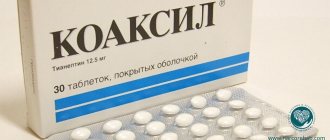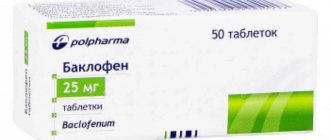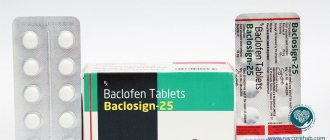Some drug addicts rely on pharmaceutical drugs, which are always available for sale and attract less attention from law enforcement agencies. Many drug addicts are even of the opinion that narcotic drugs are not so dangerous to the body.
Read further:
- Brief information about the drug
- Gabapentin is a pharmaceutical drug
- Dangerous combinations of Gabapentin
- Side effects
- Signs of using the pharmaceutical drug Gabapentin
- Withdrawal syndrome
- Consequences of using Gabapentin
- Gabapentin overdose - first aid
- Treatment of Gabapentin Addiction
Today we’ll talk about the fairly well-known pharmaceutical drug Gabapentin, learn about its narcotic effect, signs and consequences of use, symptoms of overdose and how addiction to this potent drug is treated.
Brief information about the drug
| Gabapentin - pharmacological properties | A potent anticonvulsant with a pronounced analgesic effect |
| Dosage form | Capsules, tablets |
| Methods of administration | Orally |
| Application in medical practice | Treatment of seizures, epilepsy, neuropathic pain, migraine, anxiety disorders. Dispensed by prescription. |
| Time of action | 5-7 hours |
| Compound | 300 mg of active ingredient - gabapentin, calcium stearate, sodium carboxymethyl starch, microcrystalline cellulose |
Gabapentin is a pharmaceutical drug
Based on the principle of action, the pharmaceutical drug Gabapentin is compared with the effects of the drug Lyrica. When consumed in an increased dosage, pleasure centers are disinhibited, resulting in a euphoric effect, a surge of positive emotions and other pleasant sensations. But, if you overdo the dosage a little, hallucinations and delusional states occur.
Due to regular use of Gabapentin, severe dependence and tolerance develops, against the background of which the addict constantly has to increase the usual dosage to obtain euphoric sensations.
The effect after oral administration occurs within 20-30 minutes. The narcotic effect of the drug lasts 5-12 hours. However, with regular use of pharmaceutical drugs, the period of pleasure is quickly shortened.
Pharmacological properties of the drug Gabapentin
Gabapentin is structurally similar to GABA, however, its mechanism of action differs from other drugs that interact with GABA receptors (valproate, barbiturates, benzodiazepines, GABA transaminase inhibitors, GABA uptake inhibitors, GABA agonists and GABA prodrugs). At therapeutic concentrations, it does not bind to the following receptors: GABA A and B, benzodiazepine, glutamate, glycine and N-methyl-d-aspartate. In vitro studies of labeled gabapentin have identified new peptide receptors in rat brain tissue, including the neocortex and hippocampus, which may mediate the anticonvulsant activity of gabapentin and its derivatives (the structure and function of gabapentin receptors are not fully understood). Rapidly absorbed when taken orally. Bioavailability is not proportional to the dose - with increasing dose it decreases and is: at a dose of 300 mg - 60%, at 1600 mg - 30%, respectively. Absolute bioavailability - 60% (capsules). Food, including those high in fat, does not affect the pharmacokinetics of the drug. The maximum concentration in blood plasma is achieved 2–4 hours after oral administration. Plasma concentrations are dose proportional. The maximum plasma concentration is 4.02 mcg/ml when used at a dose of 300 mg every 8 hours and 5.5 mcg/ml when used at a dose of 400 mg. Passes through the BBB and enters breast milk. Distribution volume - 57.7 l. In patients with epilepsy, the minimum concentration of gabapentin in the CSF is approximately 20% of that in plasma. The binding to plasma proteins is very weak (less than 5%). Practically not metabolized. Excreted by the kidneys. Removal from blood plasma has a linear relationship. The half-life averages 5-7 hours, does not depend on the dose (at a dose of 300 mg - 5.2 hours, at a dose of 400 mg - 6.1 hours). The elimination rate constant, plasma clearance, and renal clearance of gabapentin are directly proportional to creatinine clearance. Removed by hemodialysis. The clearance of gabapentin from blood plasma is reduced in elderly people and patients with impaired renal function; the half-life for creatinine clearance less than 30 ml/min is 52 hours. Pharmacokinetics do not change with repeated use.
Dangerous combinations of Gabapentin
Many drug addicts take Gabapentin in combination with alcohol or energy drinks, which enhance the effect of the drug. And some, in pursuit of unrealistic feelings of euphoria, take it simultaneously with other drugs. Such experiments can cost human life.
| Gabapentin + alcohol | Confusion, swelling of the face and limbs, muscle cramps, pain throughout the body. Coma and sudden death may occur |
| + Lyrics | There is an increase in adverse reactions of two drugs |
| + Morphine | Drowsiness, respiratory depression, lethargy |
Signs of using the pharmaceutical drug Gabapentin
You can suspect the use of Gabapentin as a pharmaceutical drug based on characteristic signs:
- sleep disturbance;
- the person becomes overly sociable and talkative;
- there is a lack of coordination of movements, slurred speech, unsteady gait;
- attacks of aggression may occur for no reason;
- depressive disorders;
- hallucinations, delusional states.
Some drug addicts who take this drug experience suicidal thoughts.
Special instructions for the use of Gabapentin
The drug should be discontinued or replaced with an alternative drug gradually, reducing the dose over at least 1 week. Abrupt cessation of antiepileptic drug therapy in patients with epilepsy can provoke status epilepticus. Ineffective for the treatment of absence seizures. During pregnancy, it is used only if the expected benefit to the mother justifies the possible risk to the fetus (possible slowdown in fetal growth if the therapeutic dose of 3600 mg is exceeded in terms of mg/m2). Excreted in breast milk. Its effect on breastfed newborns is unknown, so it should only be used during breastfeeding if the benefit to the mother clearly outweighs the risk to the baby. During the treatment period, it is necessary to refrain from potentially dangerous activities that require increased concentration and speed of psychomotor reactions. The safety and effectiveness of gabapentin in children under 3 years of age as adjunctive therapy for epilepsy and in children under 12 years of age as monotherapy have not been established. The safety and effectiveness of treatment for neuropathic pain in patients under 18 years of age have not been established. If drowsiness, ataxia, dizziness, increased fatigue, nausea and/or vomiting, weight gain appear in adults, and drowsiness, hyperkinesia and hostility in children, treatment should be discontinued.
Withdrawal syndrome
Withdrawal syndrome appears one day after the last dose of Gabapentin and can last up to 7-10 days. Withdrawal from this pharmaceutical drug is quite pronounced and is accompanied by painful physical and severe mental manifestations. The symptoms have much in common with the withdrawal symptoms characteristic of opium addicts.
Signs of withdrawal syndrome:
- unbearable joint and muscle pain;
- diarrhea;
- heart rhythm disturbance;
- increased sweating;
- a sharp increase in blood pressure;
- headache;
- loss of appetite;
- sleep disturbance;
- irritability, anxiety, depression.
Consequences of using Gabapentin
Recreational use of Gabapentin causes serious health consequences. This potent pharmaceutical drug destroys the central nervous system, causes severe poisoning of the body, and reduces immunity.
Common pathologies caused by uncontrolled use of Gabapentin:
- diseases of the gastrointestinal tract;
- disruption of the cardiovascular system;
- urinary tract infections;
- inflammatory diseases of the respiratory organs;
- dermatological pathologies associated with allergic reactions to the drug;
- kidney disease, leading to severe tissue swelling;
- mental disorders, chronic depression;
- convulsions;
- paranoia;
- erectile dysfunction in men.
Gabapentin, taken as a narcotic substance, significantly shortens a person's life span. Drug addicts need qualified help. The best solution is to go to a drug treatment clinic, where you can undergo comprehensive treatment for drug addiction under the supervision of experienced specialists.
Gabapentin
Adverse reactions observed in clinical studies with gabapentin are listed according to damage to organs and systems and frequency of occurrence.
The frequency of occurrence is determined as follows: very often (≥1/10), often (from ≥1/100 to <1/10), infrequently (from ≥1/1,000 to <1/100), rarely (from ≥1/100) 10,000 to <1/1,000), very rare (<1/10,000). If the frequency category was different between studies, the adverse reaction was assigned a higher category. Adverse reactions reported during the use of the drug after registration were assigned a frequency category of “unknown” (frequency cannot be calculated based on available data). In each frequency section, adverse reactions are presented in order of decreasing severity.
Infectious and parasitic diseases:
very often - viral infections; often - pneumonia, respiratory tract infection, urinary tract infection, other types of infections, otitis media.
Blood and lymphatic system disorders:
often - leukopenia; unknown - thrombocytopenia.
Immune system disorders:
uncommon - allergic reactions, including urticaria; unknown - hypersensitivity, including systemic reactions such as fever, rash, hepatitis, lymphadenopathy, eosinophilia and others.
Metabolic and nutritional disorders:
often - anorexia, increased appetite.
Mental disorders:
often - hostility, confusion, depression, anxiety, nervousness, impaired thinking, emotional lability; infrequently - deterioration of mental state; unknown - hallucinations.
Nervous system disorders:
very often - drowsiness, dizziness, ataxia; often - convulsions, hyperkinesia. dysarthria, amnesia, tremor, insomnia, headache, sensory disturbances (eg, paresthesia, hypoesthesia), loss of coordination, nystagmus, increased, decreased or absent reflexes; infrequently - hypokinesia; rarely - loss of consciousness; unknown - other movement disorders (for example, choreoathetosis, dyskinesia and dystonia).
Visual disorders:
often - visual impairment (such as amblyopia, diplopia).
Hearing and labyrinth disorders:
often - vertigo; unknown - tinnitus.
Cardiac disorders:
infrequently - palpitations.
Vascular disorders:
often - symptoms of vasodilation or arterial hypertension.
Disorders of the respiratory system, chest and mediastinal organs:
often - shortness of breath, bronchitis, pharyngitis, cough, rhinitis.
Gastrointestinal disorders:
often - constipation, diarrhea, dry mucous membrane of the oral cavity or pharynx, dyspepsia, flatulence, nausea, vomiting, abdominal pain, dental disease, gingivitis; unknown - pancreatitis.
Disorders of the liver and biliary tract:
unknown - hepatitis, jaundice.
Disorders of the skin and subcutaneous tissues:
often - swelling of the face, purpura (most often it was described as bruising that occurred as a result of physical trauma), skin rash, acne, itching of the skin; unknown - Stevens-Johnson syndrome, angioedema, erythema multiforme, alopecia, drug skin rash, including eosinophilia and systemic reactions (see section "Special Instructions").
Musculoskeletal and connective tissue disorders:
often - myalgia, arthralgia, back pain, muscle twitching; unknown - rhabdomyolysis, myoclonus.
Renal and urinary tract disorders:
unknown - urinary incontinence, acute renal failure.
Disorders of the genital organs and breast:
often - impotence; unknown - increase in the volume of the mammary glands, gynecomastia, sexual dysfunction (including changes in libido, ejaculation disorders and anorgasmia).
General disorders and disorders at the injection site:
very often - fatigue, fever; often - peripheral edema, gait disturbance, asthenia, pain of various localizations, general malaise, flu-like syndrome; infrequently - generalized edema; unknown - withdrawal syndrome (the most frequently reported adverse reactions were anxiety, insomnia, nausea, pain of various localizations and increased sweating), chest pain. There have been cases of sudden unexplained death, the connection of which with gabapentin treatment has not been established.
Laboratory and instrumental data
: often - decreased concentration of white blood cells, increased body weight; infrequently - increased activity of alanine aminotransferase, aspartate aminotransferase and bilirubin concentration in the blood plasma, hyperglycemia; rarely - hypoglycemia (mainly in patients with diabetes mellitus); unknown - hyponatremia, increased creatine phosphokinase activity.
Injuries, intoxications and complications of manipulation:
often - injuries, fractures, abrasions associated with falls.
There are reports of the development of acute pancreatitis during gabapentin therapy. The causal relationship with gabapentin remains unclear (see section "Special instructions").
There are reports of cases of myopathy with increased creatine kinase activity in patients with end-stage renal failure undergoing hemodialysis.
Cases of respiratory tract infection, otitis media, bronchitis and seizures were reported only in clinical studies. In addition, clinical studies have reported cases of aggressive behavior and hyperkinesis in children.
Gabapentin overdose - first aid
Uncontrolled use of Gabapentin often leads to overdose. This is a very dangerous condition with a direct threat to life, characterized by severe intoxication of the body.
Signs of a pharmaceutical drug overdose:
- clouding of consciousness;
- severe drowsiness;
- slurred speech;
- dizziness;
- double vision;
- lethargy;
- vomit;
- diarrhea;
- labored breathing;
- coma.
If symptoms of overdose are detected in a person who has taken Gabapentin in an increased dosage or in combination with other toxic substances that enhance the effect of the drug, it is necessary to call an ambulance.
Treatment of Gabapentin Addiction
Modern drug treatment centers provide comprehensive medical and rehabilitation treatment for addiction to Gabapentin and other pharmaceutical drugs. The course of therapeutic therapy consists of several stages:
- Hemodialysis, infusion therapy (detox). In case of acute poisoning with the drug, resuscitation measures are carried out.
- To relieve withdrawal symptoms during the abstinence period, symptomatic treatment is indicated.
- Rehabilitation therapy. Restoring the normal functioning of vital organs and systems. Increasing the body's defenses.
- Psychological help. Psychotherapy sessions. Motivation for a sober, drug-free life.
- Rehabilitation, restoration of social skills and trusting relationships with family.
A comprehensive Gabapentin drug addiction treatment program is showing positive results. Hospitalization to an inpatient drug treatment clinic is carried out routinely by prior arrangement, as well as urgently in case of poisoning with a pharmaceutical drug or in case of severe withdrawal symptoms during the period of abrupt drug withdrawal.
Treatment of Gabapentin addiction and other forms of drug addiction is carried out anonymously on a voluntary basis. The patient must give written consent to the full course of medical and rehabilitation therapy. More detailed information on all questions of interest can be obtained by telephone. Call us! We will help everyone!
Use of the drug Gabapentin
Inside, regardless of meals or with food. Epilepsy Adults and children over 12 years of age: initial dose - 300 mg 3 times a day on the first day, effective dose - 900-3600 mg / day. The maximum daily dose is 3600 mg (in 3 equal doses). The maximum interval between doses when prescribing the drug 3 times a day should not exceed 12 hours. It is possible to prescribe according to the following scheme (dose selection stage): at a dose of 900 mg, on the 1st day - 300 mg 1 time per day, on the 2nd day 1st day - 300 mg 2 times a day, on the 3rd day - 300 mg 3 times a day; at a dose of 1200 mg - 400 mg 1 time per day, 400 mg 2 times per day, 400 mg 3 times per day, respectively. Children aged 3–12 years: effective dose – 25–35 mg/kg/day in 3 divided doses. The dose can be titrated to an effective dose over 3 days: 10 mg/kg/day on the 1st day, 20 mg/kg/day on the 2nd and 30 mg/kg/day on the 3rd. In a long-term clinical study, the drug was well tolerated in doses of up to 40–50 mg/kg/day. Neuropathic pain in adults The initial dose is 300 mg 3 times a day, if necessary, the dose is gradually increased to a maximum of 3600 mg/day. Patients with impaired renal function: with creatinine clearance more than 60 ml/min - 400 mg 3 times a day; with creatinine clearance from 30 to 60 ml/min - 300 mg 2 times a day; with creatinine clearance from 15 to 30 ml/min - 300 mg 1 time per day; with creatinine clearance less than 15 ml/min - 300 mg every other day. For patients on hemodialysis who have not previously received gabapentin, it is recommended to prescribe a loading dose of 300–400 mg, and then 200–300 mg every 4 hours of hemodialysis.








